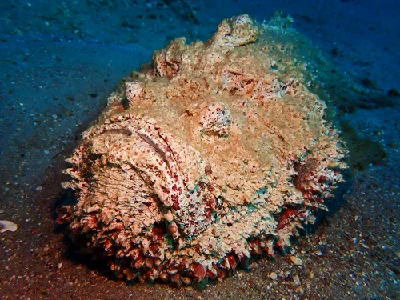Reef Stonefish
Synanceia verrucosa
Synanceia verrucosa, also known as the reef stonefish, is a venomous marine fish species that belongs to the subfamily Synanceiinae within the family Scorpaenidae. It is widely distributed and commonly found in shallow waters of the 🌊 Red Sea and the Indo-Pacific. This species possesses highly potent venom, making it the deadliest fish in the sea, with the potential to cause lethal effects in humans.
First described by German naturalists Marcus Elieser Bloch and Johann Gottlob Theaenus Schneider in 1801, Synanceia verrucosa was initially classified under the genus Synanceia. However, in 1856, Eugène Anselme Sébastien Léon Desmarest designated Scorpaena horrida as the type species for Synanceia. The specific epithet "verrucosa" refers to the warty growths covering the fish's body.
The reef stonefish displays a brown or grey coloration, with hints of yellow, orange, or red. It has 12-14 spines and 5-7 soft rays in its dorsal fin, as well as 3 spines and 5-6 soft rays in its anal fin. The dorsal spines, which contain venom glands at their base, are of equal length and covered by a thicker sheath of skin. The species lacks scales but possesses numerous warts, while its fleshy pectoral fins and wide, flattened head are distinctive features. It typically reaches a total length of 27 cm (11 in), though a maximum recorded length of 40 cm (16 in) has been documented.
The reef stonefish primarily inhabits tropical marine waters north of the Tropic of Capricorn. It is the most widespread species within the stonefish family, occurring in the western 🌊 Pacific Ocean and the 🌊 Indian Ocean. Its distribution ranges from the 🌊 Red Sea and coastal East Africa to 🇵🇫 French Polynesia, southern 🇯🇵 Japan, 🇹🇼 Taiwan, and recent evidence suggests its presence in the far eastern Mediterranean Sea. This expansion may be attributed to the release of aquarium specimens or migration through the Suez Canal (🇪🇬 Egypt). The species is commonly found in coral reefs, where it can be observed resting on rocks, plants, or the seabed.
The reef stonefish has developed various adaptations to thrive in its reef habitat. Its irregular skin texture and coloration help it blend in and remain camouflaged among rocks and corals. The presence of 13 dorsal spines with venom sacs provides additional protection when needed.
Feeding primarily on small fish, shrimp, and other crustaceans, the reef stonefish employs a sit-and-wait strategy to capture its prey. By remaining motionless on the reef floor, it waits for unsuspecting animals to swim by before engulfing them at remarkable speeds. Some stonefish have been recorded striking their prey in a mere 0.015 seconds.
Aside from its significance as an aquarium pet, the reef stonefish holds commercial value for its meat in 🇭🇰 Hong Kong markets. It is also consumed in the 🇵🇭 Philippines, particularly in Chinese restaurants, and in 🇯🇵 Japan.
Considered the most venomous fish in the world, the reef stonefish possesses 13 sharp and rigid spines along its dorsal area, each equipped with two venom sacs. These spines can penetrate boot soles. The venom is lethal, with just 18mg being capable of causing fatality when released through six of the thirteen spines. The specific protein makeup of the venom may vary among the three species of stonefish, but the reef stonefish is known for its production of verrucotoxin protein, which is responsible for its fatal effects. Symptoms of envenomation include severe pain, shock, paralysis, and tissue necrosis. A large dose can be fatal, particularly for young children, the elderly, and individuals with impaired immune systems. Medical treatment involves administration of antivenom, and local anesthetics can help alleviate pain. Immersing the affected limb in hot water is also recommended to denature the venom's proteins. However, the use of tourniquets or constrictive bandaging at the penetration site is no longer advised. Survivors of envenomation may experience nerve damage and localized muscle atrophy.
The venom comprises a mixture of proteins, including the hemolytic stonustoxin, the proteinaceous verrucotoxin, and the cardiotoxic cardioleputin.
The reef stonefish typically lives a solitary life, although it briefly aggregates with the opposite sex during mating season. Once a female reaches sexual maturity, she lays her unfertilized eggs on the reef floor. Subsequently, a male swims by and releases sperm onto the layer of eggs, fertilizing them. The stonefish eggs are relatively large, with well-developed young hatching from them. The mating system of the reef stonefish is promiscuous, as females do not discriminate between males when it comes to sperm deposition on the egg layer. Sexual dimorphism is evident, with females being larger than males.
Comments
Please, sign in to leave comment
No Comments yet
Last Update: May 28, 2025

